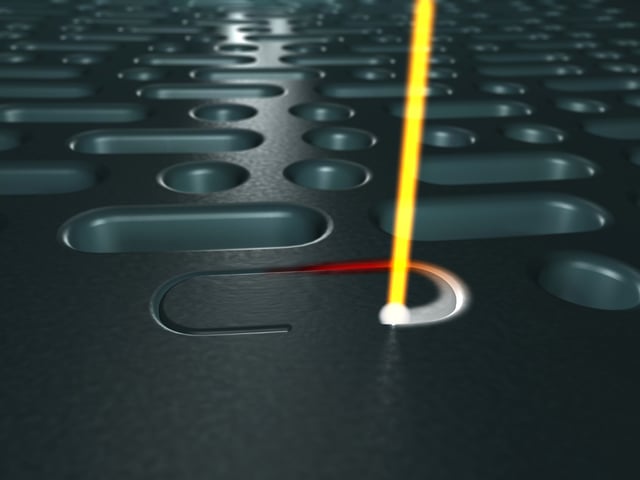
Surface roughness together with the chemical composition of the surface dictates how the material behaves when in contact with the liquid. Some level of surface roughness is always present but tailoring the surface texture for the specific need can improve the surface properties in various applications. The surface texture has been shown to influence adhesive bonding, tribological properties of the surface as well as biocompatibility of the material. For this reason, surface texturing is an often-used method for improved material properties.
There are several possible ways to produce structures on surfaces. Methods like lithography, embossing, ion beam milling can be used to produce controlled structures but are not suitable for all kinds of substrates and are slow. Etching and grid blasting have also been used but the control in those is limited. Laser texturing has gained a lot of interest during the past few years due to its superior texturing accuracy, good controllability, and suitability for various materials.
Laser texturing utilizes a focused laser beam to selectively remove material from the surface. Several parameters such as laser type, wavelength, pulse duration, pulse repetition rate, and laser power affect the outcome. Laser texturing can be used to produce various patterns such as grids, dimples, and grooves. It is possible to pattern a variety of materials including ceramics, metals, and polymers.
Laser texturing can be used to prepare a surface for adhesive bonding. By generating surface structures, the wettability and the mechanical interlocking between the bonded parts can be vastly improved. Laser texturing offers better controllability over the produced surface structures compared to the alternatives, such as sand or grit blasting, or chemical processes like etching. It is also possible to accurately control the area where the texturing is done. Some laser types have also been shown to change the chemistry of the surface by the introduction of the oxide layer. The combined effect of the increased roughness and polar surface chemistry, caused by the oxide, will improve the wettability and thus increase the adhesion strength. [1]
Tribology is the study of friction, lubrication, and wear. All of these are important concerns in applications where surface interactions exist. These applications range from mechanical components such as gears and cutting tools to biomedical implants like dental and knee replacements to electronic devices such as magnetic disks. Surface texturing is an efficient way to modify the interaction between surfaces for better lubrication, controlled friction, and enhanced wear resistance of materials. Laser texturing makes it possible to produce controlled patterns on the material surface. The effect of the texture design has been extensively studied to understand how the texture size, depth, shape, density, and alignment change the tribological properties of the surfaces [2].
Both surface chemistry and surface roughness have been shown to influence the biological response when the material comes in contact with bodily fluids. The main aim of surface texturing in biomedical applications is to enhance the cellular activity in the surface of the implant. Although other methods can also be used for surface texturing, laser texturing offers several benefits especially important in biomedical applications. Laser texturing doesn’t utilize toxic chemicals and as a non-contact method, the contamination of the surface is easily avoided. Also, both surface roughness and surface chemistry can be simultaneously altered which makes this a one-step process for improved biocompatibility [3].
[1] Maressa, P., Anodio, L., Bernasconi, A., Demir, A.G., and Previtali, B., “Effect of surface texture on the adhesion performance of laser-treated Ti6al4V alloy, The Journal of Adhesion 91 (2015) 518.
[2] Mao, B., Siddaiah, A., Liao, Y., and Menezes, P.L., “Laser surface texturing and related techniques for enhancing tribological performance of engineering materials: A review, Journal of Manufacturing Processes 53 (2020) 153.
[3] Riveiro, A., Macon, A.L.B., del Val, J., Comesana, R., and Pou, J., “Laser surface texturing of polymers for biomedical applications”, Frontiers in Physics 6 (2018) 16.
Learn about the effect of surface roughness and wettability on biocompatibility of biomaterials and medical devices.
This blog post describes the importance of fiber diameter on the contact angle measurements of fibers with Wilhelmy method
Standard contact angle measurement considers the surface's chemical properties. The influence of surface roughness is added by utilizing the Wenzel equation.
Wettability is crucial in biomedical applications as it affects protein adsorption, cell adhesion, blood coagulation, and bacterial colonization.
Liquids’ ability to wet a solid surface has widespread importance in many everyday products and industrial processes.
Membrane wettability is a key property to ensure success of membrane distillation process
Hydrophobic surface properties are needed in contact with the food product while hydrophilicity is needed when printing on food packaging.
Wettability is pivotal in pharmaceutical dosage form manufacturing as well as in drug efficacy.
Understanding the wettability of membranes is essential for optimizing these processes and achieving desired separation outcomes.
